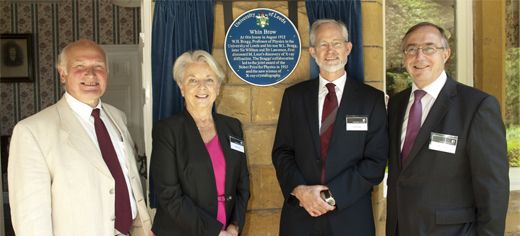
A plaque celebrating Nobel Prize-winning research at the University of Leeds that revealed the structure of crystals and revolutionised science has been unveiled at the house where it all began.
The development of X-ray crystallography by William Henry Bragg, Cavendish Professor of Physics at the University of Leeds (1908-1915), and his son William Lawrence Bragg, then a research scientist at Cambridge, paved the way for ground-breaking discoveries in the physical sciences, biology, engineering and medicine, including Watson and Crick’s work on the structure of DNA.
The Vice-Chancellor of the University of Leeds, senior academics, and Bragg family members attended the unveiling on July 5 of a blue plaque at Whin Brow, the house at Cloughton, near Scarborough, where the father-and-son team were holidaying when their collaboration began.
The Vice-Chancellor, Professor Michael Arthur, said: “We are immensely proud that the University of Leeds was the birth place of X-ray crystallography, which continues to play an important role in modern science. It is wonderful to come here today and see the place where William Henry Bragg and William Lawrence Bragg were inspired to begin the research that led to their discovery.”
The Braggs were staying at Whin Brow at the invitation of family friends when they began discussing a letter from a former student of William Henry Bragg about experiments by Max Laue in Germany showing that x-rays were diffracted by crystals. The X-ray crystallography technique that the Braggs developed over the next two years allowed scientists to peer into the atomic structure of crystals by looking at the patterns made by the diffraction.
Charles Bragg, a direct descendant of the father-and-son duo, who unveiled the plaque, said: “It is a great honour to unveil the plaque at Whin Brow, where my grandfather and great-grandfather spent their summer holiday in 1912 discussing the recent discovery of X-ray photography by Laue.
“Their work, which followed this trip, was a true partnership, with William Henry Bragg’s great experimental ability and his skill at developing sophisticated equipment at the University of Leeds, which William Lawrence Bragg then used to derive many atomic structures,” he added.
At least 20 Nobel Prizes in physics, biology, chemistry and medicine, including momentous discoveries such as the structures of DNA, haemoglobin and insulin, have relied on the technique. The Braggs were awarded the Nobel Prize in 1915–the only father and son ever to have won the honour.
Further information
For media enquiries, please contact Sarah Reed, Press Officer, University of Leeds on 0113 34 34196 or email s.j.reed@leeds.ac.uk.
Image: From left to right - Dr Chris Hammond, Life Fellow in Material Science at the University of Leeds; Linda Pollard, pro-Chancellor of the University; Charles Bragg, the great-grandson of William Henry Bragg; Professor Michael Arthur, Vice-Chancellor of the University.